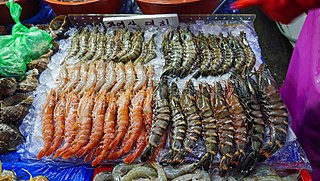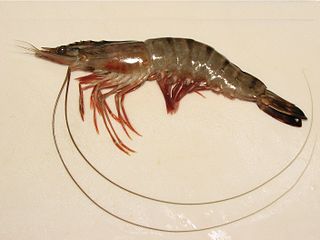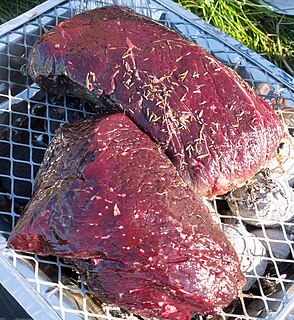 W
WThe Chinese white shrimp, oriental shrimp, or fleshy prawn is a species of shrimp. It is cultivated at an industrial level off mainland China. Production was devastated by a series of epidemics in the 1990s and early 2000s. Its wild capture has since recovered and expanded, but it is now farmed at lower levels than previously.
 W
WThe common cuttlefish or European common cuttlefish is one of the largest and best-known cuttlefish species. They are a migratory species that spend the summer and spring inshore for spawning and then move to depths of 100 to 200m during autumn and winter. They grow to 49 cm in mantle length (ML) and 4 kg in weight. Animals from subtropical seas are smaller and rarely exceed 30 cm in ML.
 W
WEels are elongated fish, ranging in length from 5 centimetres (2.0 in) to 4 metres (13 ft). Adults range in weight from 30 grams to over 25 kilograms. They possess no pelvic fins, and many species also lack pectoral fins. The dorsal and anal fins are fused with the caudal or tail fin, forming a single ribbon running along much of the length of the animal. Most eels live in the shallow waters of the ocean and burrow into sand, mud, or amongst rocks. A majority of eel species are nocturnal and thus are rarely seen. Sometimes, they are seen living together in holes, or "eel pits". Some species of eels live in deeper water on the continental shelves and over the slopes deep as 4,000 metres (13,000 ft). Only members of the family Anguillidae regularly inhabit fresh water, but they too return to the sea to breed.
 W
WIkizukuri (生き作り), also known as ikezukuri (活け造り), is the preparing of sashimi from live seafood. In this Japanese culinary technique, the most popular sea animal used is fish, but octopus, shrimp, and lobster may also be used.
 W
WSome species of jellyfish are suitable for human consumption and are used as a source of food and as an ingredient in various dishes. Edible jellyfish is a seafood that is harvested and consumed in several East and Southeast Asian countries, and in some Asian countries it is considered to be a delicacy. Edible jellyfish is often processed into a dried product. Several types of foods and dishes may be prepared with edible jellyfish, including salads, sushi, noodles, and main courses. Various preparation methods exist.
 W
WA kipper is a whole herring, a small, oily fish, that has been split in a butterfly fashion from tail to head along the dorsal ridge, gutted, salted or pickled, and cold-smoked over smouldering wood chips.
 W
WLobsters are a family of large marine crustaceans.
 W
WMarine mammals are a food source in many countries around the world. Historically, they were hunted by coastal people, and in the case of aboriginal whaling, still are. This sort of subsistence hunting was on a small scale and produced only localised effects. Dolphin drive hunting continues in this vein, from the South Pacific to the North Atlantic. The commercial whaling industry and the maritime fur trade, which had devastating effects on marine mammal populations, did not focus on the animals as food, but for other resources, namely whale oil and seal fur.
 W
WPrawn is a common name for small aquatic crustaceans with an exoskeleton and ten legs, some of which can be eaten.
 W
WThe prawn cracker is a form of deep fried snack made from starch and prawn. Prawn crackers are a common snack food in Southeast Asian cuisine, but they are most closely associated with Indonesia and Malaysia. They have also been adapted into East Asian cuisines.
 W
WThe Prawns from Palamós is a crustacean of the species Aristeus antennatus. The exactly same crustacean is also fished in the mediterranean Spanish towns of Denia and Garrucha, and also in Huelva, where its quality is regarded as even higher than those fished in Palamós. It presents a very intense red color and it is valued for its fine, firm and tasty meat. It is fished with the technique of bottom trawling and in summer they are usually found more exemplaries and bigger.
 W
WPyura chilensis, called piure in Spanish, is a tunicate of the family Pyuridae. It was described in 1782 by Juan Ignacio Molina.
 W
WSashimi is a Japanese delicacy consisting of fresh raw fish or meat sliced into thin pieces and often eaten with soy sauce.
 W
WScampi, also called Dublin Bay Prawn or Norway Lobster, is an edible lobster of the order Decapoda. It is widespread in the Mediterranean and northeastern Atlantic, from North Africa to Norway and Iceland, and is a gastronomic delicacy. Scampi is now the only surviving species in the genus Nephrops, after several other species were moved to the closely related genus Metanephrops.
 W
WSea cucumbers are marine animals of the class Holothuroidea. They are used as food, in fresh or dried form, in various cuisines. In some cultural contexts the sea cucumber is thought to have medicinal value.
 W
WShark meat is a seafood consisting of the flesh of sharks. Several sharks are fished for human consumption, such as porbeagles, shortfin mako shark, requiem shark, and thresher shark, among others. Shark meat is popular in Asia, where it is often consumed dried, smoked, or salted. Shark meat is consumed regularly in Iceland, Japan, Australia, parts of India, parts of Canada, Sri Lanka, areas of Africa and Mexico. In western cultures, shark meat is sometimes considered as a taboo, although its popularity has increased in Western countries.
 W
WShrimp and prawn are types of seafood that are consumed worldwide. Although shrimp and prawns belong to different suborders of Decapoda, they are very similar in appearance and the terms are often used interchangeably in commercial farming and wild fisheries. A distinction is drawn in recent aquaculture literature, which increasingly uses the term "prawn" only for the freshwater forms of palaemonids and "shrimp" for the marine penaeids.
 W
WSquid is eaten in many cuisines; in English, the culinary name calamari is often used for squid dishes. There are many ways to prepare and cook squid. Fried squid is common in the Mediterranean. In Lebanon and Syria, it is served with tartar sauce. In New Zealand, Australia, the United States and Canada, and South Africa, it is sold in fish and chip shops. In Britain, it can be found in Mediterranean 'calamari' or Asian 'salt and pepper fried squid' forms in various establishments, often served as a bar snack, street food, or starter.
 W
WWhale meat, broadly speaking, may include all cetaceans and all parts of the animal: muscle (meat), organs (offal), skin (muktuk), and fat (blubber). There is relatively little demand for whale meat, compared to farmed livestock. Commercial whaling, which has faced opposition for decades, continues today in very few countries, despite whale meat being eaten across Western Europe and colonial America previously. However, in areas where dolphin drive hunting and aboriginal whaling exist, marine mammals are eaten locally as part of a subsistence economy: the Faroe Islands, the circumpolar Arctic, other indigenous peoples of the United States, St. Vincent and the Grenadines, some of villages in Indonesia and in certain South Pacific islands.